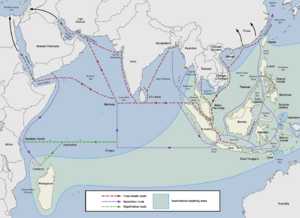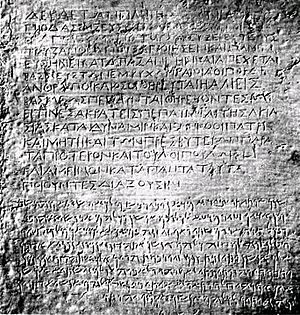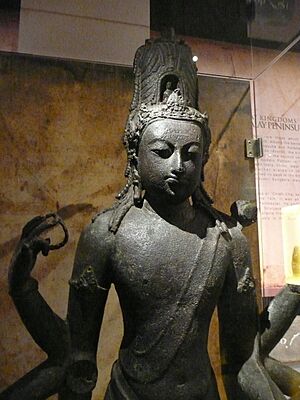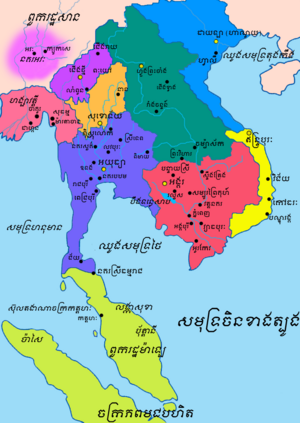History of Indian influence on Southeast Asia facts for kids

For a long time, from about 290 BCE to the 15th century CE, Southeast Asia was greatly influenced by India. This period saw many ideas from Hinduism and Buddhism become part of local governments and ways of life. Kingdoms along India's southeastern coast traded and shared culture with places like Burma, Thailand, Cambodia, and the Philippines.
This sharing of culture is often called "Indianization." It meant that Southeast Asian kingdoms adopted many Indian ideas. These included religious beliefs, ways of governing, and even parts of the Sanskrit language. Interestingly, Indian culture itself was a mix of many different traditions. Some of these traditions even came from early Southeast Asian groups. This might be why Indian culture was so easily accepted in Southeast Asia.
Indian traders, teachers, and priests played a big role in spreading these influences. They traveled by sea until about 1500 CE. Both Hinduism and Buddhism spread from India to these new lands. For many centuries, these religions lived side-by-side peacefully. Over time, most mainland Southeast Asian countries became mainly Buddhist.
Contents
How Indian Culture Spread to Southeast Asia
The main reasons Indian culture spread to Southeast Asia were busy trade routes and important missions. These included sea trade networks, especially for spices. Also, Ashoka the Great, a powerful Indian emperor, sent Buddhist missions to share his beliefs.
Sea Trade and Connections
Sailors from Southeast Asia first connected with southern India and Sri Lanka around 500 BCE. This early trade brought Southeast Asian goods to India. It also linked the cultures of India and China. These sea routes later became part of the larger Spice trade network. This constant contact led to a lot of cultural exchange.
Ancient Indian texts mention ships and navies. The first clear navy in India was organized by Chandragupta Maurya around 322 BCE. Emperor Ashoka later used his navy for diplomatic missions. As trade grew, India looked to the Malay Peninsula for gold. This led to more sea trade routes and connections with other parts of the world.
Buddhist Missions from India
Around 250 BCE, during Emperor Ashoka's rule, Buddhist missions were sent out. These missions aimed to spread Buddhism to many "border areas." Monks traveled to places like Sri Lanka, Kashmir, and the Himalayas. They also went to Southeast Asian regions like Suvaṇṇabhūmi, which might have been parts of modern-day Burma and Thailand.
Historians believe these missions were real. They think Ashoka himself helped fund these efforts. This royal support helped Buddhism become a major religion. Ashoka's daughter, Sanghamitta, also went to Sri Lanka. She helped start an order of nuns there.
Trade and Religion in Later Centuries
From the early Common Era to the Middle Ages, Hindu and Buddhist centers in Southeast Asia grew. They became linked to trade and business. People gave money to religious groups. This money was then used to help the local economy. Buddhism, in particular, traveled along sea trade routes. It helped spread the use of coins, art, and reading and writing.
In places like Java and Borneo, Indian culture led to a demand for spices. Trading posts there later served Chinese and Arab markets. Ships from India and Sri Lanka carried goods from the Maluku Islands (Spice Islands). These goods traveled all the way to the Near East and even East Africa.
The ancient region of Kalinga (modern Odisha) in eastern India was very important for sea trade. Its people sailed along the Indian coast and to Southeast Asia. They shared their culture, including Hinduism. The annual Bali Jatra festival still celebrates these old traditions today.
The Chola dynasty in southern India was very powerful. Emperors Rajaraja Chola I and Rajendra Chola I expanded their kingdom. Their navies even conquered parts of Srivijaya, a large empire in Southeast Asia. This helped Indian goods and ideas spread even further.
Kollam in Kerala, India, was a famous trading port. It traded with China and was mentioned by the traveler Ibn Battuta. Indian trade links with Southeast Asia were also important for merchants from Arabia and Persia.
The Maritime Silk Road
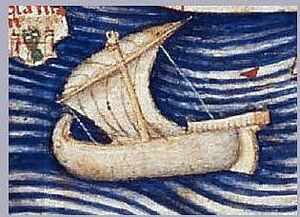
The Maritime Silk Road was the sea part of the famous Silk Road. It connected China to Southeast Asia, India, the Arabian Peninsula, and even Europe. This trade route included many seas, like the South China Sea and the Indian Ocean. It was also part of the Spice trade and other sea trade networks.
How Religions Spread Along Trade Routes
Trade routes like the Silk Road didn't just carry goods. They also helped spread ideas and cultures, especially religions. Religions like Buddhism, Christianity, and Islam traveled across Asia through these trade networks. Buddhist monasteries along the Silk Road offered safe places for travelers. They also introduced a new religion to many people.
Sometimes, different cultures mixed. For example, Chinese and nomadic groups exchanged ideas. The nomads learned Chinese farming, and the Chinese adopted some nomadic military skills and music.
Buddhism's Journey Along the Silk Road


Buddhism began spreading to China via the Silk Road in the 1st century CE. It then spread throughout Southeast, East, and Central Asia. The Buddhist community, called the Sangha, included monks, nuns, and regular followers. They traveled to share Buddha's teachings.
The Kushan Empire helped spread Buddhism to China and other parts of Asia. Many Buddhist monks traveled to Chinese lands. The first people to translate Buddhist texts into Chinese came from places like Parthia and Kushan.
Emperor Ashoka's conversion to Buddhism also helped. He made Buddhism an official religion in his northern Indian empire. This increased knowledge about Buddhism along the Silk Road.
From the 4th century CE, Chinese pilgrims traveled to India. They wanted to find original Buddhist scriptures. Famous travelers like Xuanzang made long journeys to India. His travels were even made into a fantasy novel called Journey to the West.
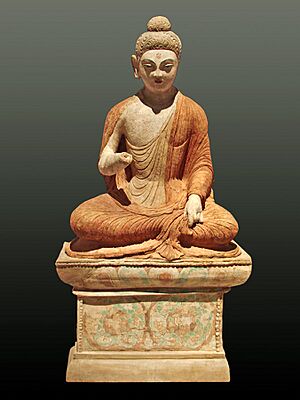
Many different types of Buddhism traveled along the Silk Road. Over time, a form called Mahayana Buddhism became very popular. This form focused on spiritual understanding rather than just material things.
Merchants played a big role in spreading Buddhism. They found its teachings appealing. They supported Buddhist monasteries, which offered them places to stay during their travels. In return, merchants helped spread Buddhism to new places. These communities often became centers for learning and culture. The spread of Buddhism along the Silk Road mostly ended around the 7th century with the rise of Islam.
Indian Influence in Specific Southeast Asian Countries
Brunei
Before European explorers arrived, Brunei had Indian-influenced Hindu-Buddhist kingdoms. One early state was Vijayapura in the 7th century. It was likely part of the powerful Srivijaya empire. Later, a state called Po-ni had ties with China. By the 14th century, Po-ni was influenced by the Javanese Majapahit Empire. In 1402, the first ruler of Brunei converted from Hindu-Buddhism to Islam.
Burma (Myanmar)
The Mon people in Lower Burma were strongly influenced by Indian traders. Around the 3rd century BCE, they adopted Indian literature, art, and Buddhism. The Mons were one of the earliest civilizations in Southeast Asia. They founded kingdoms like Thaton Kingdom.
Later, Tibeto-Burman tribes moved south and founded their capital at Bagan. They adopted Mon civilization and Buddhism. The Bagan Kingdom united Burma for 200 years. King Anawratha (1044–1077) built many famous temples in Bagan.
Cambodia
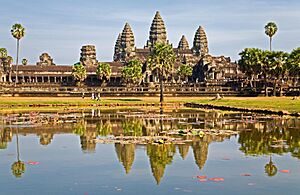
The first major Indian-influenced state in Cambodia was the Kingdom of Funan. It was founded in the 1st century CE. Funan traded with India and China. Its leaders adopted Indian culture, including statecraft and art.
Later, the Khmer Empire grew powerful. King Jayavarman II (around 800–850) founded the capital at Angkor. He started a cult that linked the king to the Hindu god Shiva. The Angkor empire flourished for centuries. Its most famous monument is the great temple of Angkor Wat, built in the 12th century.
East Timor
The people of East Timor were not great seafarers. They connected with the outside world through foreign traders from China and India. These traders brought metal goods, rice, and textiles.
Oral stories in East Timor mention people migrating from an Indian-influenced Hindu-Buddhist empire called Srivijaya. Later, the Javanese Hindu empire of Majapahit also claimed Timor as a tributary. The name "Timor" itself might come from a Sanskrit word for "mountain."
Indonesia
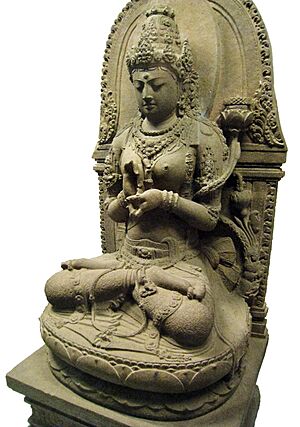
For over a thousand years, from the 5th to 15th centuries, many Indian-influenced states thrived in Indonesia. These kingdoms were politically independent from India.
The Buddhist Malay kingdom of Srivijaya became very famous. Its capital was Palembang in Sumatra. Srivijaya controlled the important sea route from India to China. It became the leading state in Southeast Asia from the 6th to 7th centuries. Buddhism became very strong there.

In Java, the powerful Buddhist Sailendra dynasty built many temples. The most impressive is Borobudur, thought to be the world's largest Buddhist temple. The Sailendras later moved to Sumatra, joining with Srivijaya. This combined empire ruled much of Southeast Asia for five centuries.
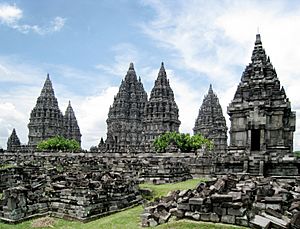
Other kingdoms like Mataram Kingdom and Kediri also rose in Java. Kediri became a strong trading nation, especially for spices. Later, the Majapahit kingdom appeared in eastern Java. It returned to Hinduism and controlled many islands in the region.
Laos
The first kingdom in Indochina was Kingdom of Funan. It was an Indian-influenced kingdom that adopted Indian ideas about government, religion, and writing. Later, the Chenla kingdom took over. Its capital was near Wat Phu, a large temple complex in southern Laos.
The Khmer Empire also grew in the 9th century. In northern Laos, the Mon people created their own kingdoms. They introduced Theravada Buddhism from Sri Lanka.
Malaysia
The Malay Peninsula has been settled for a very long time. Trade with India and China began in the 1st century BC. In the early centuries CE, people in Malaysia adopted Hinduism and Buddhism. The Sanskrit writing system was used as early as the 4th century.
Ancient Indian texts might refer to the Malay Peninsula as the "Golden Peninsula." Archeologists have found old settlements in Bujang Valley dating back to 110 AD. These show early Indian influence.
Between the 7th and 13th centuries, much of the Malay Peninsula was under the Buddhist Srivijaya empire. This empire was based on trade. The Chola dynasty from southern India also had a big impact. They invaded Srivijaya cities in the 11th century. These events were so important that they are still remembered in Malay stories.
The power of Srivijaya declined from the 12th century. Wars and the spread of Islam weakened it. By the 14th century, the Hindu Java-based Majapahit empire controlled the peninsula. Later, Islam became the main religion, and sultanates like the Sultanate of Malacca rose.
Philippines
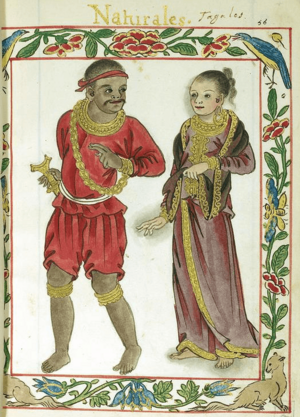
The Philippines also had Indian-influenced kingdoms. The Srivijaya empire and the Kingdom of Mataram both had influence there. Around Manila, there were three early kingdoms that were Hindu-Buddhist before becoming Islamic and then Catholic. The Laguna Copperplate Inscription, the oldest known written document in the Philippines, uses an Indian-influenced script and Sanskrit words.
The Rajahnate of Cebu was a Hindu kingdom founded by Sri Lumay. He was a prince from the Chola dynasty in India. He rebelled and started his own kingdom. His grandson, Rajah Humabon, was involved in the famous Battle of Mactan against Ferdinand Magellan.
In Mindanao, the Rajahnate of Butuan was a Hindu kingdom. Its first king, Rajah Kiling, might have been from India. Another kingdom, Sanmalan, might have been ruled by the Indian Chola dynasty.
Many Indian-influenced artifacts have been found in the Philippines. These include a gold pendant of Garuda (a Hindu deity's mount) and statues of the Hindu god Ganesha. The Golden Tara statue from Butuan is another famous example.
Singapore
The ancient Greek geographer Ptolemy mentioned a place called Sabana at the tip of the Malay Peninsula, which might be Singapore. Early Chinese records also mention the island as Pu Luo Chung.
In 1025 CE, Rajendra Chola I from India invaded the Srivijaya empire. His forces might have controlled Temasek (now Singapore) for some time. The name Temasek means "Sea Town" or "Sea Port."
Hindu-Buddhist Kingdom in Singapore
The Malay Annals tell a story about the founding of Singapore. A prince from Srivijaya, Sri Tri Buana (also known as Sang Nila Utama), landed on Temasek in the 13th century. He saw a strange animal he thought was a lion. He took this as a good sign and founded a settlement called Singapura, meaning "Lion City" in Sanskrit. While there were no lions in Singapore, the lion is a common symbol in Hindu stories.
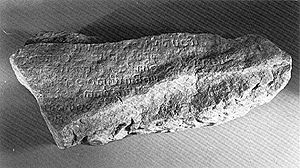
By the 14th century, Singapore was caught between the powerful kingdoms of Siam (Thailand) and Majapahit (Java). The last king, Sultan Iskandar Shah, fled to Melaka and founded the Sultanate of Malacca. Modern discoveries show that Singapore was an important settlement in the 14th century.
Thailand
India's biggest cultural gift to Thailand is Buddhism. Buddhist monks sent by King Asoka in the 3rd century BCE helped spread it. Today, most Thais are Buddhist. Thailand also adopted other Indian traditions, especially for royal ceremonies.
During the Sukhothai period (1275–1350), Indian merchants and Brahmins (Hindu priests) settled in Thailand. Brahmins played an important role in the Siamese court. They were experts in astrology and ceremonies. The idea that the king is a reincarnation of the Hindu god Vishnu came from India. Even today, Thai kings are called Rama, after an incarnation of Vishnu.
More Tamil merchants came to Thailand during the Ayutthaya kingdom era (1350–1767).
Indian Cultural Influence on Thailand
Indian culture has deeply influenced Thai dance, language, and festivals.
- Dance: Thai literature and drama are inspired by Indian arts and Hindu stories. The Hindu epic Ramayana is very popular in Thailand. Thailand has its own version called the Ramakien. Classical Thai dances like the Khon and Lakhon draw inspiration from the Ramakien.
- Language: The Thai language has many words from Sanskrit and Pali, ancient Indian languages. King Ram Khamhaeng the Great created the Thai alphabet in 1283. He based it on old Indian alphabets.
- Religious Ceremonies and Festivals: Many Thai ceremonies come from Indian tradition. These include ceremonies for marriage and cremation. Hindu gods are also worshipped in Thailand, especially in royal ceremonies.
- The Giant Swing Ceremony was originally a Brahmin ceremony to honor the god Shiva.
- The Royal Ploughing Ceremony marks the start of the farming season.
- Loy Krathong is a festival of lights where people float lanterns. It is an act of worship to the Water Goddess.
- Songkran Festival marks the Thai New Year. It is similar to Indian festivals like Holi.
- Visakha Puja Day celebrates the birth, enlightenment, and death of Buddha.
- Hindu Astrology: Many Thai people still use Hindu astrology to find lucky days for important events like moving house or getting married.
- Medicine and Cuisine: Thai traditional medicine, including herbal remedies, was influenced by Indian Ayurveda. Some plants used in Thai medicine came from India. Thai cuisine also learned to use spices in different ways from Indian cuisine.
Vietnam
Northern Vietnam was influenced by China for a long time. It was a Chinese province until the 10th century. In south-central Vietnam, the Cham people established the Hindu kingdom of Champa around 400 CE. Champa faced invasions from its neighbors but survived for centuries. In 1471, a Vietnamese army invaded Champa, causing many Cham people to flee or be forced to adopt Vietnamese culture.
Unlike most other Southeast Asian countries, Vietnam was mainly influenced by Buddhism through Chinese culture, not directly from India.
See also
- Spread of Indian influence
- Greater India
- Indosphere
- Buddhism in Southeast Asia
- Hinduism in Southeast Asia
- Indianization of Southeast Asia
- Trading routes
- Indian maritime history
- Silk Road
- Ancient maritime history
- Other related
- List of Southeast Asian leaders
- Southeast Asian Games
- Southeast Asia Treaty Organization
- Tiger Cub Economies


